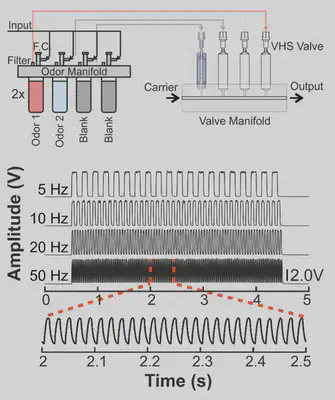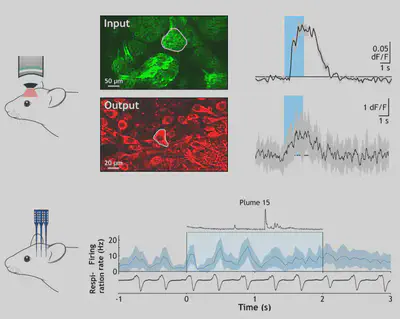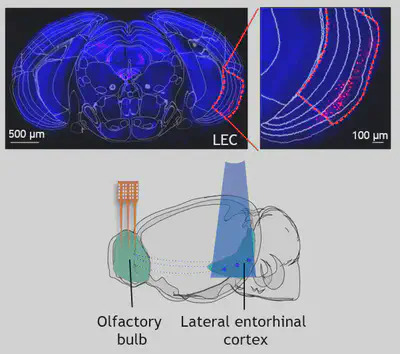Research projects
Representation of complex odours across the mammalian olfactory system
In this project, we plan to examine how temporally complex odour information is represented and transformed within the olfactory bulb (OB) and across its major downstream cortical target regions using in vivo imaging and electrophysiology.
Cellular and circuit mechanisms underlying complex odour processing in mice
The aim of this project is to gain a mechanistic understanding of temporally complex odour processing in the olfactory bulb by perturbing the local inhibitory circuitry as well as cortical feedback projections.
Olfactory navigation using complex odour information
Tracking an odour to its source can be of vital importance in the search for food, potential mating partners or to avoid encounters with a predator. The goal of this project is to investigate how temporal features of odour plumes inform odour-guided navigation.
Key methods and techniques
Odour delivery To present odour stimuli in a controlled and temporally precise manner, we developed a high-speed odour delivery device ("tODD", Ackels et al., 2021). Temporally complex odour plumes of different chemical identity, concentration and across a range of temporal profiles are presented to animals. Mice are, for example, head-fixed on a treadmill where we record the animal's respiration profile to present odour stimuli precisely during a particular time of the respiration cycle, typically triggered to the start inhalation. |
|
| Recording neural activity We use dual-color 2-Photon Ca2+ imaging and extracellular probes to record neuronal activity from populations of neurons in different parts of the olfactory system. To understand how temporally complex odour stimuli are respresented and processed, we analyse neural activity on a single cell and population level, and use machine learning-based data analysis together with computational modelling methods. |
|
| Circuit interrogation The neuronal mechanisms underlying processing of temporally complex odours remain unknown. To investigate this, we perturb and manipulate neuronal activity using opto- and chemogenetic techniques. Employing viral vectors in combination with transgenic mouse lines allows us to target specific cell populations during physiology and behavioural experiments. |
|
| Animal behaviour In an olfactory-guided navigation task, we investigate which features of complex, naturalistic olfactory cues are informative to animals tracking an odour to its source. In a behavioural arena, animal movement is tracked along with the odour profile that it encounters. In addition, we monitor the animal’s respiration strategy and record neural activity in different olfactory brain regions. |
|



